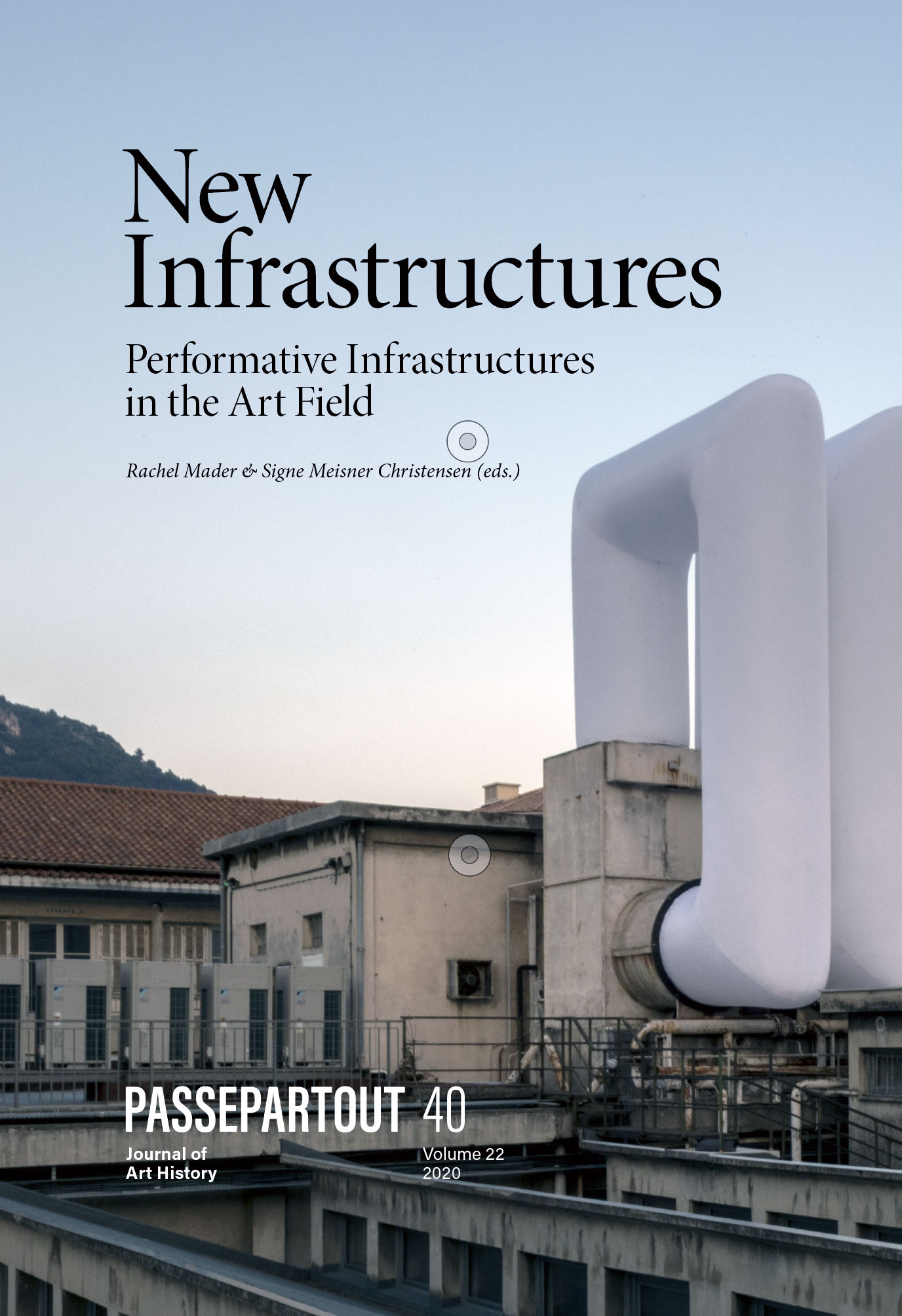Institutions as Semantic Forms
Examples of Self-Organized Practices in Switzerland
Nøgleord:
Institution, self-organization, Switzerland, Kunsthalle, ImaginationResumé
With reference to different examples of self-organized Swiss art projects, this article highlights how the ‘institution’—especially Kunsthallen—can be a (literal) infrastructure for running a project. As such, institutions act more as semantic forms. However, this does not mean that they are merely simulated or faked, but rather that these semantic forms serve as vessels for artistic ends of social connections and imagination of production, which ultimately create something concerned with institutional imagination.
Referencer
Anderson, Benedict: Imagined Communities, London, 1983.
Cassirer, Ernst: “Der Begriff der symbolischen Form im Aufbau der Geisteswissenschaften”, in Cassirer (eds), Gesammelte Werke. Hamburger Ausgabe (ECW). Darmstadt, 1998 (1923), pp. 62–87.
Banz, Stephan: “Komplexes System Kunst”, in Kuhn et al [eds], Fink forward : the collection/connection, Zürich, 1998, online (http://www.editionfink.ch/oldsite/collection/, accessed July 26, 2016).
Bastian, M.S.; Isabelle, L.: Bastomania, Zürich, 2018.
Bourriaud, Nicolas: Relational aesthetics, Dijon-Quetigny, 2008.
de Pina-Cabral, João: “Afterword: What is an institution?” in Social Anthropology/Anthropologie Sociale, Vol. 19, issue 4, 2011, pp. 363–527.
European Kunsthalle 2018, http://eukunsthalle.com (accessed November 12, 2018).
Haus am Gern: Interview with the Author, October 2018.
Haus am Gern: “Roggwil-Wynau: Dampf wo sonst Kunst”, in Kunstbulletin, January/February 2000, online (https://www.hausamgern.ch/krw/pressetext.html, accessed November 12, 2018).
Haus am Gern: “Kunsthale Roggwil-Wynau. k-r-w (arbeitstitel)”, leaflet, 1997 (private archive Haus am Gern).
Hofstetter, Erwin: Interview with the Author, October 2018.
Kramis, Eva: “Reden vom Ende der Kunsthalle. Heute findet die vorläufig letzte GV der Kunsthalle Luzern statt”, in n/a, 1993 [newspaper article in private archive of Erwin Hofstetter].
Kretz, Nicolette: “Schaust Du noch Kunst oder machst Du schon Party? Über die Rolle des Biertrinkens mit Freunden in der Kulturvermittlung,” in Bern and Krähenbühl (eds), Transform. Kunst Raum Prozesse. Nürnberg, 2015, pp. 33–36.
Kunst, Bojana: “The Institutionalisation, Precarity and the Rhythm of Work” in Kunstpunt, 2017, online (https://www.kunsten.be/dossiers/perspectief-kunstenaar/perspective-institution/4450-the-institutionalisation-precarity-and-the-rhythm-of-work, accessed November 12, 2018).
Kunsthalle Tropical: “I. – The Space Connects Human Beings,” twitter-post, 24.06.2017 (https://twitter.com/KunsthalleT/status/878537831274119168, accessed November 12, 2018).
Landert, Markus: “Der Konzeptkünstler H.R. Fricker. Sichtung eines Lebenswerks” in Landert and Hoefert (eds), H. R. Fricker: Erobert die Wohnzimmer dieser Welt! [exhibition catalogue, Kunstmuseum Thurgau, 18.09.2011-15.04.2012], Zürich, 2012, pp. 15–30.
Meury, Marcel, Interview with the Author, October 2018.
Möntmann, Nina: Kunst als sozialer Raum. Andrea Fraser, Martha Rosler, Rikrit Tiravanija, Renée Green, Köln, 2018.
Widmer, Peter: Die traumatische Verfassung des Subjekts. Das Körperbild und seine Störungen, Wien, 2016.
Zwez, Annelise: “Haus am Gern: Ein Unternehmen nach allen Regeln der Kunst” in Bieler Tagblatt, April 24, 2001, online (http://annelisezwez.ch/2001/haus-am-gern-ein-unternehmen-nach-allen-regeln-der-kunst/, accessed November 12, 2018).
Cassirer, Ernst: “Der Begriff der symbolischen Form im Aufbau der Geisteswissenschaften”, in Cassirer (eds), Gesammelte Werke. Hamburger Ausgabe (ECW). Darmstadt, 1998 (1923), pp. 62–87.
Banz, Stephan: “Komplexes System Kunst”, in Kuhn et al [eds], Fink forward : the collection/connection, Zürich, 1998, online (http://www.editionfink.ch/oldsite/collection/, accessed July 26, 2016).
Bastian, M.S.; Isabelle, L.: Bastomania, Zürich, 2018.
Bourriaud, Nicolas: Relational aesthetics, Dijon-Quetigny, 2008.
de Pina-Cabral, João: “Afterword: What is an institution?” in Social Anthropology/Anthropologie Sociale, Vol. 19, issue 4, 2011, pp. 363–527.
European Kunsthalle 2018, http://eukunsthalle.com (accessed November 12, 2018).
Haus am Gern: Interview with the Author, October 2018.
Haus am Gern: “Roggwil-Wynau: Dampf wo sonst Kunst”, in Kunstbulletin, January/February 2000, online (https://www.hausamgern.ch/krw/pressetext.html, accessed November 12, 2018).
Haus am Gern: “Kunsthale Roggwil-Wynau. k-r-w (arbeitstitel)”, leaflet, 1997 (private archive Haus am Gern).
Hofstetter, Erwin: Interview with the Author, October 2018.
Kramis, Eva: “Reden vom Ende der Kunsthalle. Heute findet die vorläufig letzte GV der Kunsthalle Luzern statt”, in n/a, 1993 [newspaper article in private archive of Erwin Hofstetter].
Kretz, Nicolette: “Schaust Du noch Kunst oder machst Du schon Party? Über die Rolle des Biertrinkens mit Freunden in der Kulturvermittlung,” in Bern and Krähenbühl (eds), Transform. Kunst Raum Prozesse. Nürnberg, 2015, pp. 33–36.
Kunst, Bojana: “The Institutionalisation, Precarity and the Rhythm of Work” in Kunstpunt, 2017, online (https://www.kunsten.be/dossiers/perspectief-kunstenaar/perspective-institution/4450-the-institutionalisation-precarity-and-the-rhythm-of-work, accessed November 12, 2018).
Kunsthalle Tropical: “I. – The Space Connects Human Beings,” twitter-post, 24.06.2017 (https://twitter.com/KunsthalleT/status/878537831274119168, accessed November 12, 2018).
Landert, Markus: “Der Konzeptkünstler H.R. Fricker. Sichtung eines Lebenswerks” in Landert and Hoefert (eds), H. R. Fricker: Erobert die Wohnzimmer dieser Welt! [exhibition catalogue, Kunstmuseum Thurgau, 18.09.2011-15.04.2012], Zürich, 2012, pp. 15–30.
Meury, Marcel, Interview with the Author, October 2018.
Möntmann, Nina: Kunst als sozialer Raum. Andrea Fraser, Martha Rosler, Rikrit Tiravanija, Renée Green, Köln, 2018.
Widmer, Peter: Die traumatische Verfassung des Subjekts. Das Körperbild und seine Störungen, Wien, 2016.
Zwez, Annelise: “Haus am Gern: Ein Unternehmen nach allen Regeln der Kunst” in Bieler Tagblatt, April 24, 2001, online (http://annelisezwez.ch/2001/haus-am-gern-ein-unternehmen-nach-allen-regeln-der-kunst/, accessed November 12, 2018).
Downloads
Publiceret
2020-12-11
Nummer
Sektion
Artikler





